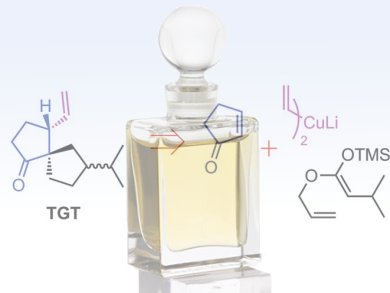Vetiver Oil and the Vetiver Rule
Approximately one third of all fragrances on the market contain vetiver oil as a key ingredient, for which no synthetic odorant is commercially available. Instead it has to be distilled from the dried roots of vetiver grass. To find out about the structural requirements of vetiver odorants, researchers in Switzerland devised a synthesis to a 7,8-seco-khusimone, which still contained all the structural features held responsible for the vetiver odour. As they report in the European Journal of Organic Chemistry, however, the final product displayed none of the expected olfactory characteristics, thus proving the vetiver rule wrong.
Vetiver oil has a distinct and characteristic suave and sweet woody-earthy odour with additional green grapefruit and rhubarb-type facets. In perfumery it is often used to provide the woody base note in combination with rather inexpensive bergamot oil, or its synthetic counterparts, which provides a fresh citrus component. Currently, there is no synthetic vetiver perfumery material available commercially. This lack of availability is partially due to the complex sesquiterpene nature of its constituents, and partially due to the lack of consensus as to which constituents contribute to its characteristic odour. One component for which there is consensus is (–)-khusimone, which forms only up to 2 % of the essential oil, but does present a typical vetiver odour and is, so far, the only genuine natural lead structure. Syntheses of related structures led to the development of a vetiver rule, which postulates that the woody odour of vetiver is a result of the presence of an α-branched carbonyl osmophore at a specific distance from a bulky group, with an overall dimension of 13–15 carbon atoms.
Applying the Vetiver Rule to a Lead Structure
Philip Kraft and Natacha Denizot, Givaudan, Switzerland, thus decided to apply this vetiver rule to the genuine lead structure khusimone itself in order to design a new vetiver odorant with even improved olfactory properties, and in addition an easier synthetic access.
The target structure, 7,8-seco-khusimone, was obtained as a mixture of diastereomers in a 10-step sequence starting from commercially available allyl alcohol and isovaleric acid. A key advantage of the sequence is that it fairly easily allows further modifications of the target structure. Although the desired compound was synthesised successfully it was 10 times less intense than (–)-khusimone and displayed a floral, rosy, green, germanium-like odour with no woody or vetiver character. Kraft and Denizot, therefore, conclude that the vetiver rule has been proved wrong, or at least that the structural requirements are more complex than first suggested.
- Synthesis of a Spirocyclic Seco Structure of the Principal Vetiver Odorant Khusimone,
Philip Kraft, Natacha Denizot,
Eur. J. Org. Chem. 2012.
DOI: 10.1002/ejoc.201201318




